論説

概要
- Despite the outsize importance of credit in SME markets, many banks’ current lending programs suffer from outdated, cumbersome, and time-consuming processes.
- Fintechs and neobanks, meanwhile, have gained ground with attractive credit offerings and fast response powered by advanced technology platforms and data analytics.
- As banks devise a more comprehensive digital lending program, they can benefit from a few core principles: carefully choose the credit products to digitalize first, design to delight clients, know where the internal barriers are, and orchestrate the program with relationship managers.
When it comes to banking services, small and medium-size enterprises (SMEs) often are underserved by a proposition that’s not quite retail, not quite corporate—and thus not well tailored for their varied needs. Given the relevance and profitability of this business, and the growing level of competition from neobanks and fintechs, that’s an untenable position for traditional banks.
Depending on how banks segment customers, SMEs can represent up to one-quarter of the total loan book. Even in a low-interest-rate environment, SMEs can account for a risk-adjusted return in the low double digits. But despite the attractiveness of the SME market, serving these firms presents a challenge: creating a differentiated experience while remaining cost-efficient. Digital tools and channels will be integral to such an approach, especially if directed first at the most important area—credit.
Like larger corporations, SMEs have a broad spectrum of needs that require personalized advice from an expert, be it a relationship manager or product specialist. At the same time, most SMEs embrace digitalization, especially when it makes products simpler, faster, and more convenient to use. A recent Bain & Company survey in Australia found that SMEs count simple products, digital interfaces, and consistent execution among their top five banking criteria.
Serving SMEs with a variation of a retail digital model fails to meet their more complex needs. But adopting a corporate-like full-coverage team both costs too much and fails to support account managers in serving SMEs, because they naturally emphasize larger accounts in their portfolios. Digitalization done right can unravel this knot, particularly when deployed in a model that keeps the relationship manager at the core and draws on an ecosystem of services that clients may use for self-service in digital or hybrid digital-human channels. This approach delivers the greatest value when applied to the bread-and-butter realm of credit.
Many banks began their digitalization efforts in the easiest areas—payments and everyday banking. Now, however, digital lending for SMEs has become crucial to master. Some 33% of SMEs surveyed by Bain cited medium- or long-term borrowing and 29% cited short-term borrowing as among the top three priorities when managing their finances (see Figure 1). Clients who give high Net Promoter® scores for their bank’s lending experience are roughly 2.5 times more willing than those giving low scores to take new products with the bank.
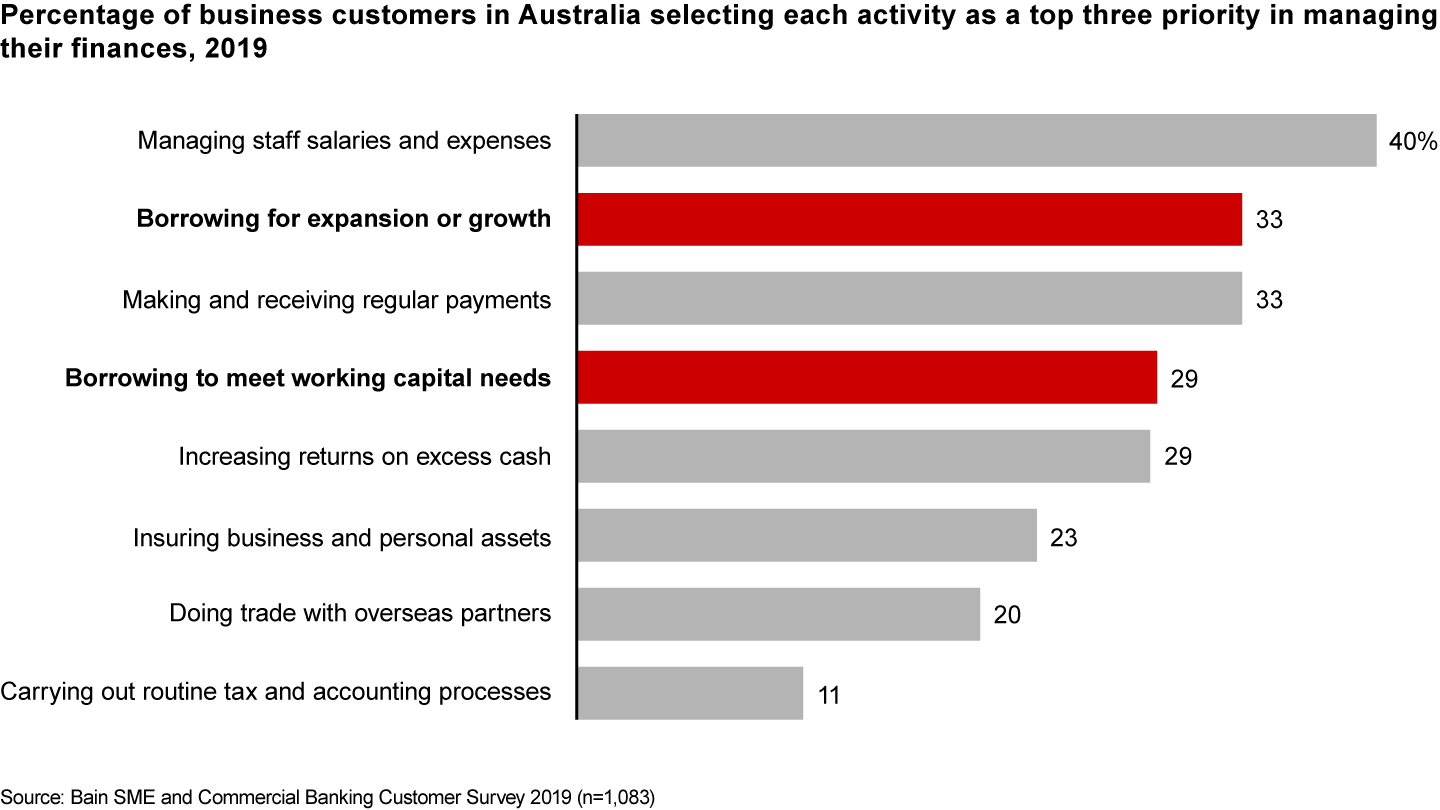
Moreover, lending constitutes up to 70% of total bank revenues for the SME segment in certain Western European countries, our analysis of one major bank shows. It also serves as a foundation for cross-selling, as SMEs with loans from a bank purchase twice as many other products as clients without credit lines (see Figure 2).
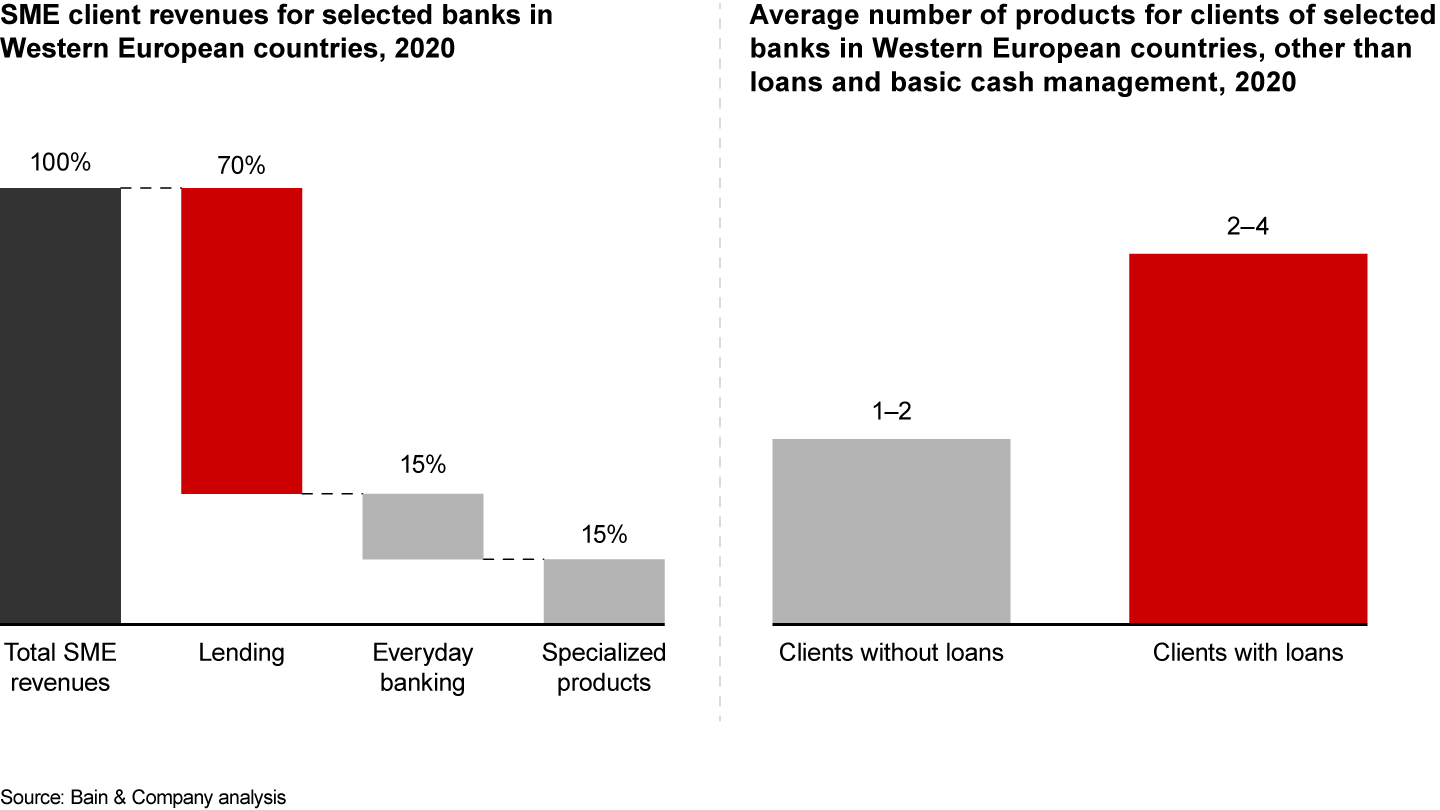
Unfortunately, the current lending experience at many banks suffers from outdated processes. Clients can wait up to 30 days for a response to their credit application, and that application can consume 2 to 8 hours for relationship managers, who spend much of that time in redundant, low-value administrative tasks (see Figure 3).
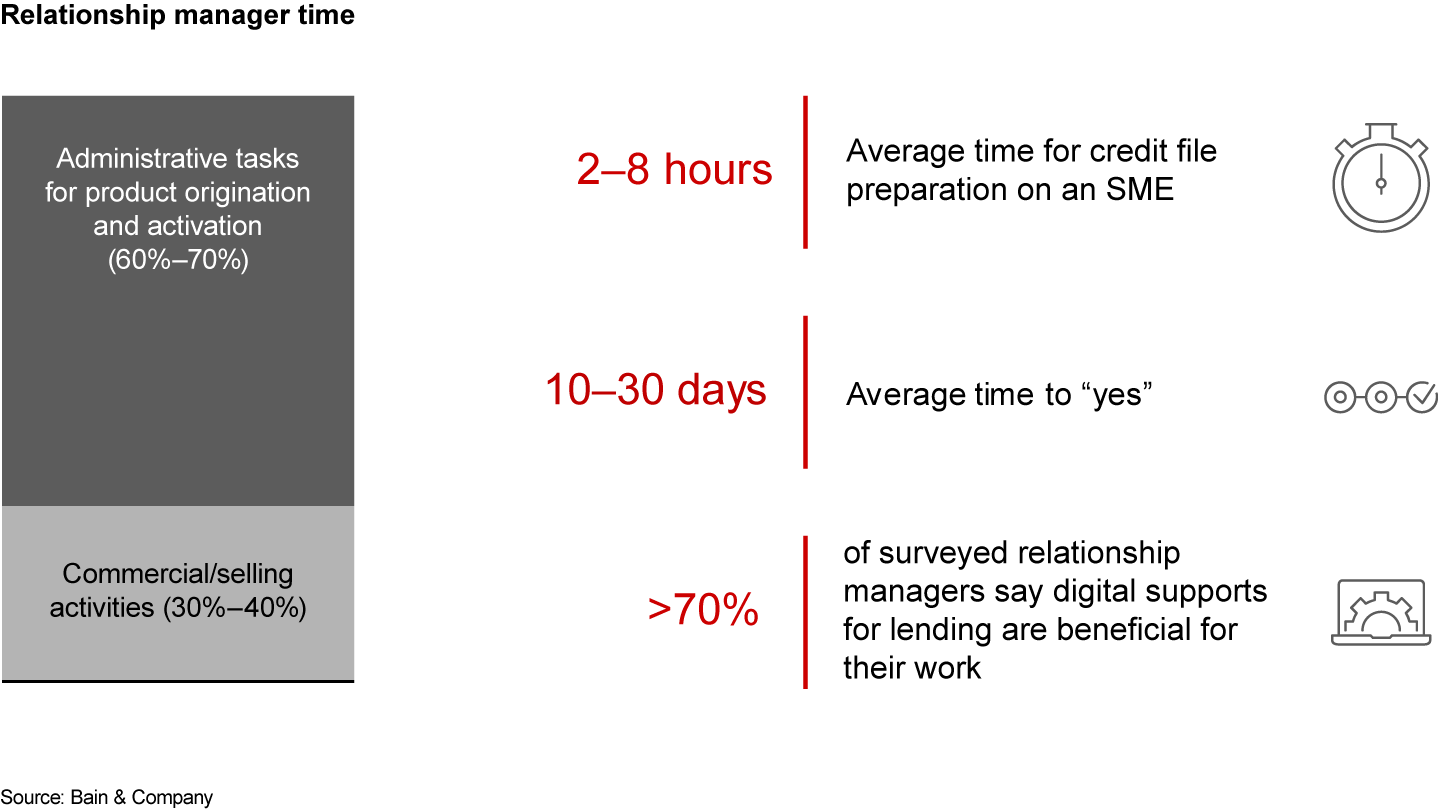
Not just a pretty interface
Enter the promise of digital tools and channels, which have become even more prominent since the onset of the Covid-19 pandemic. A recent Bain survey found that between 60% and 80% of business clients are willing to work remotely with their bank for simpler products and touchpoints, such as net working capital financing or legal signatures.
Fintechs, meanwhile, have been gaining ground in this market. According to a 2021 study by EY, 36% of SMEs are considering moving away from their traditional banking provider, with some 31% considering a fintech as an alternative. The best fintechs manage to attract SMEs by discerning their needs and priorities, delivering attractive offerings characterized by a top-notch, end-to-end digital experience with convenient interfaces and fast responses. Most use advanced technology platforms and data analytics, embedding artificial intelligence in their systems. They’re also transparent about pricing and features.
As banks respond to this challenge, they run the risk of falling short. With pressure to deliver results quickly, it’s tempting to put up an attractive front-end interface and declare mission accomplished. Yet that approach limits any benefits and may create more problems, such as:
- delays in releases and time to market;
- cumbersome interfaces that confuse customers and eventually cause them to drop out during the episode;
- foregone opportunities for cross-selling; and
- low adoption rates, leading to a low return on the digital investment.
Instead, initiatives must go well beyond the interface, to change how SMEs interact with their bank; in other words, banks should aim to develop comprehensive digital experiences, not simply digitize existing processes. Typically, an incumbent bank will need to depart from its stratified legacy technologies and complicated internal processes. It should address the client’s experience end to end and closely align with relationship managers’ activities.
As banks devise a more comprehensive digital lending program, they can proceed by following a few core principles.
Choose your battles. Select the product lines that are most relevant in terms of client penetration, revenues, and complexity to use. These could include lower-margin, high-penetration overdraft lines for short-term or medium- to long-term unsecured financing. Another early target could be forms for invoice discounting, which take up client and relationship manager time. Start small, test the product and its features through new digital methods, and then add features and extend the logic to more sophisticated products, such as foreign trade lending (see Figure 4).
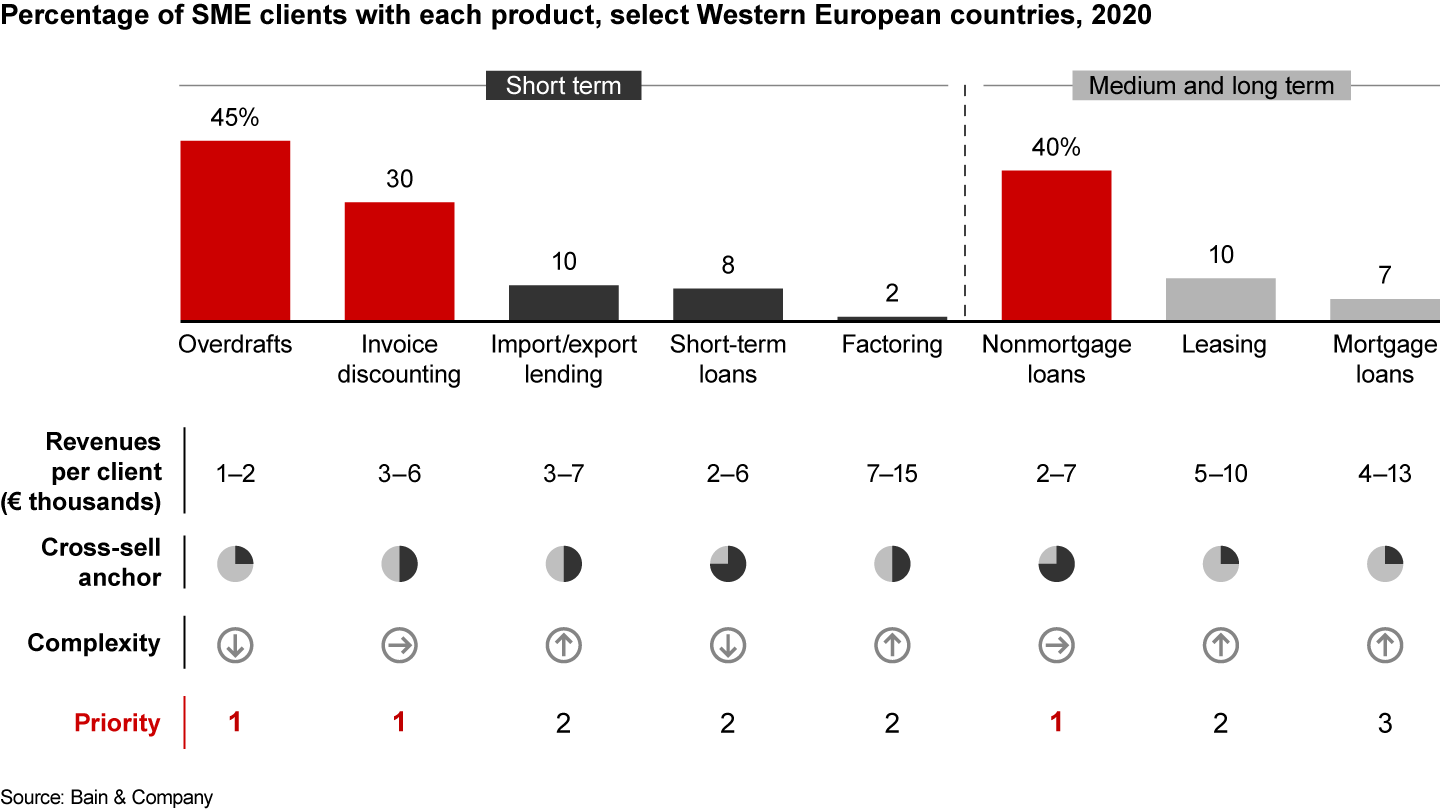
As a side benefit, this exercise can spur a streamlining of outdated process steps. One European bank that reviewed its portfolio of technical forms in lending decided to close dozens of forms that it deemed marginal or redundant.
Design to delight. Designing a great digital experience calls for a clear understanding of client needs, which can vary depending on the segment, product line, and product configuration. The interface must be simple to understand, flawless to navigate, and able to handle most concerns that could pop up. One large Italian bank, for example, launched a credit application workflow that allows customers to complete a full credit request in under 10 screens with a single signature.
Another design challenge is that an SME client may have multiple users and counterparties, with different levels of authority and who engage at different touchpoints. Internal processes may prevent an optimal design for every stage of the client’s journey. In this case, it’s important to identify the process interruptions and manual activities that might need to continue temporarily, and gradually improve or eliminate those over time by redesigning the entire episode. Another European bank decided to continue with manual power-of-attorney checks on clients prescreened for the pilot of its new digital process, while sourcing an external vendor to automate the step in a subsequent release.
Know your starting point. High-street banks don’t enjoy the modern, flexible technology stack of neobanks. Besides the IT burden, they also must deal with a tangle of internal processes, structures, and tools. Deep-rooted credit policies and systems lay down the law when it comes to lending.
Take the underwriting domain. If speed is one ingredient of success in digital lending, the underwriting department must excel in targeting clients, running real-time simulations of product features and conditions, building a high-caliber workflow to process requests, and installing engines for instant credit decisions, credit line settlement, and automated disbursement. The large Italian bank cited earlier developed a scoring engine to automatically assess clients’ credit eligibility, which helped reduce time-to-cash from 5 days to 15 minutes and provided the basis for a digital offering connected to it.
Setting clients’ expectations will be critical here. For larger loans or state-backed products, immediate approval may not be feasible. And some requests will continue to involve assistance from a relationship manager. Having a clear understanding of internal processes, their capability to deliver, and their pain points is a prerequisite for a realistic development roadmap. A bank must also prioritize clear and honest communications, in order to instill trust.
Coordinate with your front line. Digital lending should expand the opportunities for clients to purchase in self-service mode or with the support of a relationship manager freed of many administrative tasks. However, a digital system does risk including moments where clients could drop off.
The human touch has a role to play here, as SMEs still value advice, and cross-selling may be more effective in a hybrid model. So, no matter how many products or processes go digital, it’s critical to work hand in glove with relationship managers.
A European bank upgraded its CRM tool to assist in orchestrating the customer experience across different channels (see Figure 5). Now that the CRM tool links to the digital lending system and gathers data on clients’ progress, it provides a wealth of information to relationship managers: what the customer is doing online; notification of drop-out points, so the relationship manager can step in to help; and behavioral data that can inform the relationship manager’s suggestions.
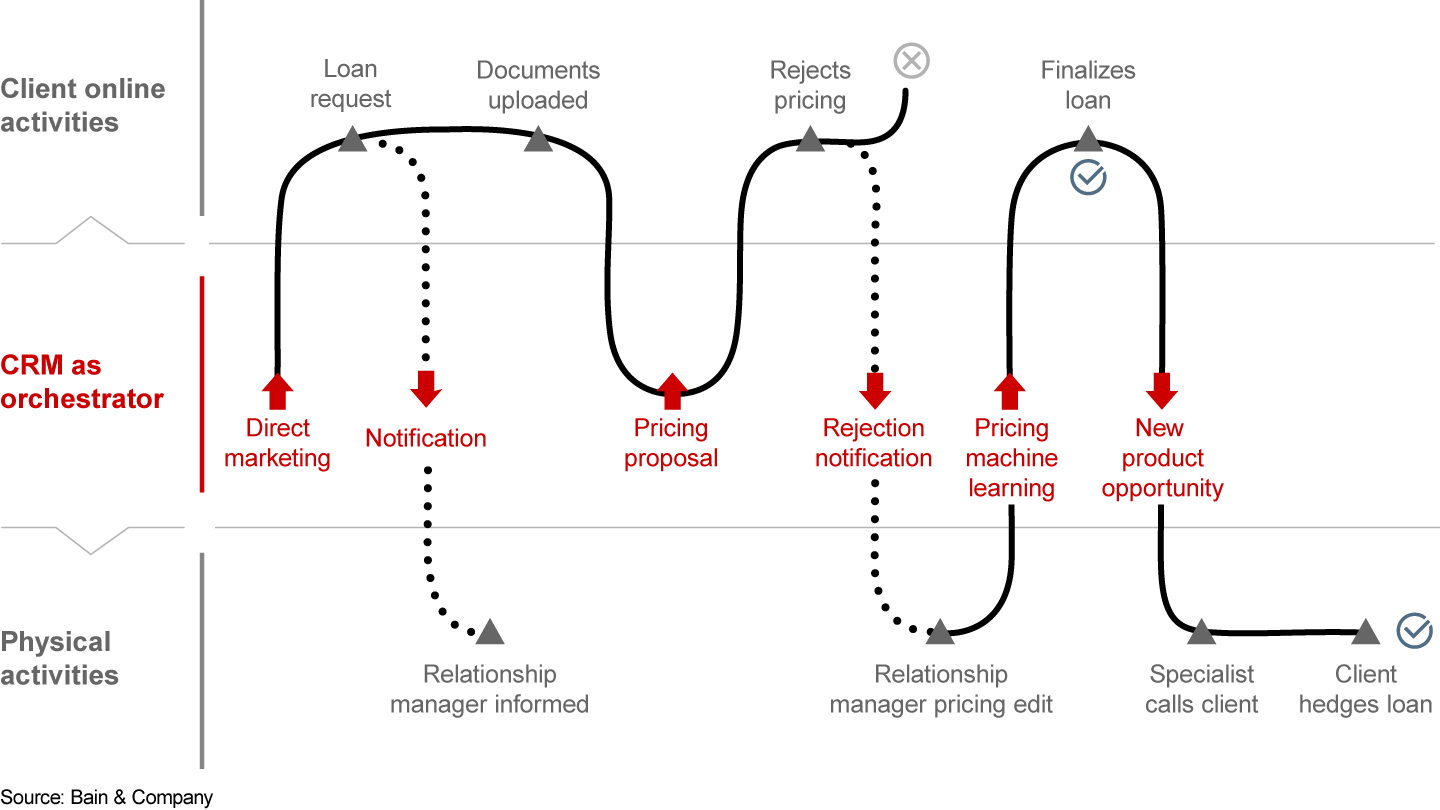
Hard choices for setting the plan
As with any ambitious initiative, digital lending will entail choices on several dimensions:
- where to locate the change (in the core bank with its existing IT, or as a separate digital attacker that could be integrated back into the legacy bank);
- which capabilities are a source of competitive advantage and should be built, and which can be “good enough” and bought externally;
- how to structure agile, multifunctional units to accelerate development;
- how to set up a feedback loop with clients in order to keep improving; and
- how to govern the transformation and choose the right metrics to track progress.
With a robust, comprehensive digital lending program, banks will be better positioned to expand their reach with SMEs and earn their loyalty for other products in the years ahead.
Net Promoter®, NPS®, and the NPS-related emoticons are registered trademarks of Bain & Company, Inc., Satmetrix Systems, Inc., and Fred Reichheld. Net Promoter Score℠ and Net Promoter System℠ are service marks of Bain & Company, Inc., Satmetrix Systems, Inc., and Fred Reichheld.




